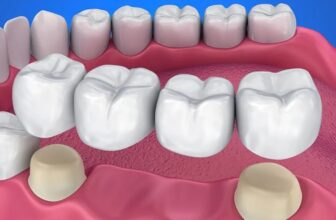
Dental braces in Dubai are widely regarded as one of the most effective solutions for straightening misaligned teeth. Whether you’re dealing with overcrowding, crooked teeth, or bite issues, braces provide a reliable way to achieve a more aesthetically pleasing and functional smile. In this article, we will explore why dental braces in Dubai are essential for correcting misaligned teeth, the benefits they offer, and how they can significantly improve both your appearance and oral health.
The Importance of Straightening Misaligned Teeth:
Aesthetic Benefits:
One of the primary reasons people choose braces is for aesthetic reasons. Misaligned teeth can significantly affect the appearance of your smile, which can impact your self-confidence. Braces help realign your teeth, making them straighter and more symmetrical, which leads to a more attractive smile. A straight smile can have a positive influence on how others perceive you, boosting your overall self-esteem.
Functional Benefits:
Straight teeth are not only important for appearance but also for function. Misaligned teeth can make it difficult to chew and speak properly. For example, teeth that are crowded or crooked can cause difficulty in biting food, leading to uneven wear and potential jaw pain. By straightening your teeth, braces improve the overall function of your mouth, making eating, speaking, and even breathing more comfortable.
Common Types of Misalignment Treated with Braces:
Overbite or Underbite:
An overbite occurs when the upper teeth overlap too far over the lower teeth, while an underbite happens when the lower teeth extend beyond the upper teeth. Both conditions can cause difficulty in chewing, speaking, and even breathing. Braces are effective in correcting both overbites and underbites by realigning the teeth and jaw to their proper positions.
Crossbite:
A crossbite happens when one or more of the upper teeth bite inside the lower teeth. This misalignment can result in tooth wear, gum disease, and bone loss. Braces can help move the upper teeth outward to restore proper alignment and prevent long-term dental damage.
Open Bite:
An open bite occurs when the upper and lower teeth don’t come together when the mouth is closed. This can cause speech difficulties and affect the ability to chew. Braces correct open bites by gradually shifting the teeth into alignment, allowing for a proper bite.
Crowding:
Crowding occurs when there isn’t enough space in the mouth for all the teeth to fit properly. This can lead to teeth overlapping, making it difficult to clean the teeth properly, which increases the risk of cavities and gum disease. Braces help create space between teeth and move them into their correct positions.
How Braces Work to Straighten Teeth:
The Process of Tooth Movement:
Braces apply constant, gentle pressure to your teeth, gradually shifting them into the desired position over time. The process involves the following stages:
- Initial Placement: Braces are bonded to your teeth with a special adhesive, and small metal or ceramic brackets are attached. These are connected by a thin wire that holds them in place.
- Regular Adjustments: Over time, your orthodontist will tighten the wire to apply more pressure, causing your teeth to shift. This process is typically done every 4 to 6 weeks.
- Bone Remodeling: As the pressure is applied, the bone around the teeth breaks down and reforms to accommodate the new position of the teeth.
Types of Braces Available:
There are several types of braces available, each offering unique advantages depending on your treatment needs and preferences:
- Traditional Metal Braces: These are the most common type of braces and consist of metal brackets and wires. While they are highly effective, they are more visible than other options.
- Ceramic Braces: Ceramic braces work in the same way as metal braces but are made from clear or tooth-colored materials, making them less noticeable.
- Invisalign (Clear Aligners): These are transparent, removable aligners that gradually straighten the teeth without the use of brackets or wires. While not suitable for all types of misalignment, Invisalign offers a discreet option for patients who prefer not to wear traditional braces.
Benefits of Straightening Misaligned Teeth:
Improved Oral Health:
Misaligned teeth can lead to problems such as tooth decay, gum disease, and jaw pain. Crooked teeth can be harder to clean effectively, as brushing and flossing around crowded teeth is more challenging. As a result, plaque and bacteria can build up, increasing the risk of cavities and gum issues. By straightening your teeth with braces, you improve your ability to maintain proper oral hygiene, reducing the risk of these problems.
Better Chewing and Speech Function:
Misalignment can make it difficult to chew certain foods properly, which may affect your digestion. Straight teeth allow for more efficient chewing and help to break down food effectively, which can improve digestion. Additionally, an improper bite can impact your speech. Braces can correct issues that affect how your teeth meet, leading to clearer and more accurate speech.
Prevention of Future Dental Problems:
Misaligned teeth can lead to long-term complications if left untreated, such as uneven wear on teeth, jaw problems (temporomandibular joint dysfunction), and increased risk of tooth fractures. Braces help align your teeth correctly, reducing the likelihood of these problems occurring and ensuring the longevity of your teeth.
The Role of an Orthodontist in Your Treatment:
Comprehensive Evaluation:
Before starting braces treatment, an orthodontist will perform a thorough evaluation of your teeth, gums, and jaw. This may include X-rays, digital scans, and molds of your teeth to assess the severity of the misalignment and determine the best course of action. Based on this evaluation, the orthodontist will develop a personalized treatment plan that addresses your unique needs.
Monitoring Progress:
Throughout the treatment process, your orthodontist will regularly monitor your progress and make necessary adjustments to ensure that your teeth are moving as planned. Regular check-ups are crucial to ensure that your braces are working efficiently and to address any issues that may arise during treatment.
Timeline for Braces Treatment:
Average Treatment Duration:
The duration of braces treatment can vary depending on the complexity of the dental issues being addressed. On average, braces treatment lasts between 18 to 24 months. However, some patients may require shorter or longer treatment times based on their individual needs. Regular visits to your orthodontist and adherence to treatment guidelines can help ensure the most efficient timeline.
Post-Treatment Retainers:
Once your braces are removed, your orthodontist will likely provide retainers to help maintain the new position of your teeth. Retainers are essential in ensuring that your teeth stay straight and do not shift back to their previous positions. It’s important to follow the orthodontist’s instructions regarding the wear of retainers to maintain your results.
Conclusion:
Dental braces in Dubai are an essential and effective solution for correcting misaligned teeth. Whether you’re dealing with crowded teeth, an overbite, or other alignment issues, braces provide the means to improve both the aesthetic and functional aspects of your smile. Not only do they enhance your appearance, but they also contribute to better oral health, improved chewing, and clearer speech. Working with an experienced orthodontist ensures that your treatment is personalized to meet your specific needs and will result in a beautiful, healthy smile for years to come.







